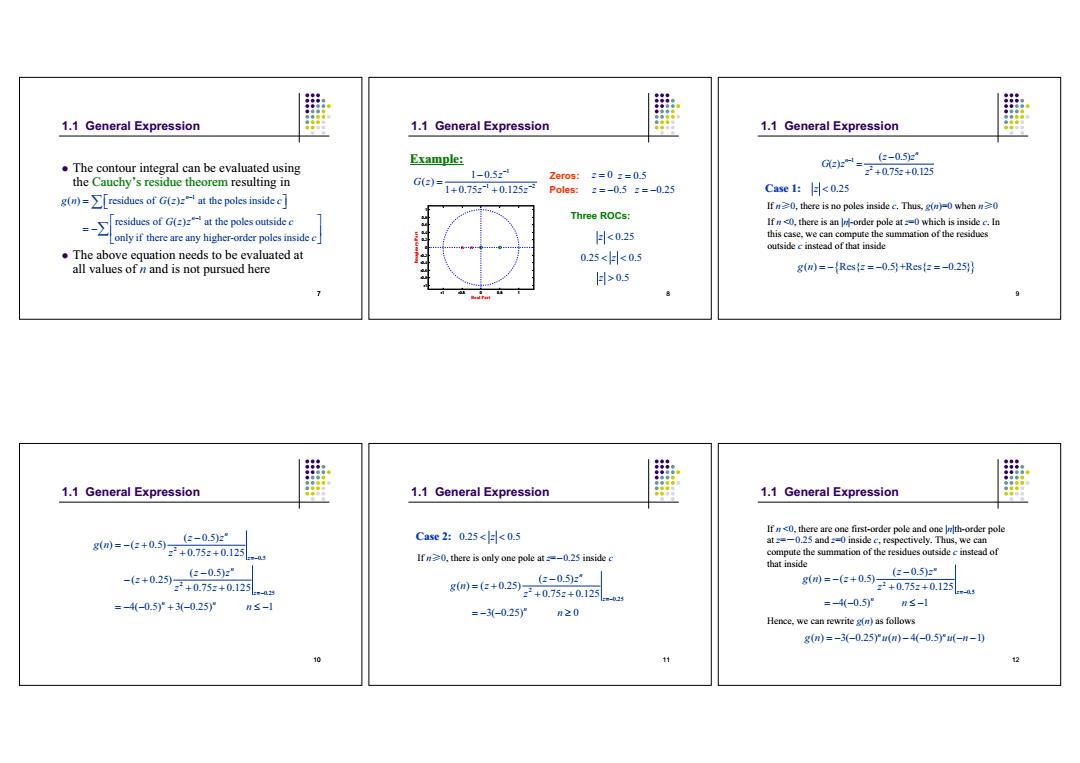正在加载图片...

1.1 General Expression 1.1 General Expression 1.1 General Expression Example: (2-0.5z The contour integral can be evaluated using 1-0.52 Zer0s:2=0z=0.5 Ge=7+075z+02四 the Cauchy's residue theorem resulting in G8)=1+0.752+0.1252 Poles: 2=-0.5z=-025 Case 1:<0.25 g(n)=residues of G()at the poles insidec If n20,there is no poles inside c.Thus,g(n)=0 when n0 residues of G(=)at the poles outsidee Three ROCs: only if here ar any higher-oder pe If n <0,there is an r-order pole at ==0 which is inside c.In <0.25 this case,we can compute the summation of the residues outside c instead of that inside The above equation needs to be evaluated at 0.25<H<0.5 all values of n and is not pursued here g(m)=-{Rcs杠=-0.5+Res杠=-025} H>0.5 7 1.1 General Expression 1.1 General Expression 1.1 General Expression If n<0,there are one first-order pole and one nlth-order pole (2-0.5)z g=-(e+0.52+0.752+0.12可 Case2:0.25<H<0.5 at 2=-0.25 and :=0 inside c,respectively.Thus,we can If n0,there is only one pole at ==-0.25 inside c compute the summation of the residues outside e instead of that inside (2-0.5)z -e+020z+0.75z+0.12 (2-0.5z”1 (z-05)z -a 8(m)=(2+0.25) 8(m=-(z+0.5) 02+0.75z+0.125 z2+0.75z+0.125 =-4(-0.5)°+3(-0.25) nS-1 =-4-0.5”n≤-1 =-3-0.25H n20 Hence.we can rewrite g(n)as follows g(m)=-3-0.25yu(m-4(-0.5yu(-n-1) 10 127 1.1 General Expression The contour integral can be evaluated using the Cauchy’s residue theorem resulting in The above equation needs to be evaluated at all values of n and is not pursued here 1 1 ( ) residues of ( ) at the poles inside residues of ( ) at the poles outside only if there are any higher-order poles inside n n gn Gzz c Gzz c c
8 1.1 General Expression Example: Example: 1 1 2 1 0.5 ( ) 1 0.75 0.125 z G z z z Zeros: z 0 z 0.5 Poles: z 0.5 z 0.25 -1 -0.5 0 0.5 1 -1 -0.8 -0.6 -0.4 -0.2 0 0.2 0.4 0.6 0.8 1 Real Part Imaginary Part Three ROCs: z 0.25 0.25 0.5 z z 0.5 9 1.1 General Expression Case 1: Case 1: z 0.25 1 2 ( 0.5) ( ) 0.75 0.125 n n z z Gzz z z If nı0, there is no poles inside c. Thus, g(n)=0 when nı0 If n <0, there is an |n|-order pole at z=0 which is inside c. In this case, we can compute the summation of the residues outside c instead of that inside gn z z ( ) Res { 0.5}+Res{ 0.25} 10 1.1 General Expression 2 0.5 2 0.25 ( 0.5) ( ) ( 0.5) 0.75 0.125 ( 0.5) ( 0.25) 0.75 0.125 4( 0.5) 3( 0.25) 1 n z n z n n z z gn z z z z z z z z n 11 1.1 General Expression Case 2: Case 2: If nı0, there is only one pole at z=ˉ0.25 inside c 0.25 0.5 z 2 0.25 ( 0.5) ( ) ( 0.25) 0.75 0.125 3( 0.25) 0 n z n z z gn z z z n 12 1.1 General Expression If n <0, there are one first-order pole and one |n|th-order pole at z=ˉ0.25 and z=0 inside c, respectively. Thus, we can compute the summation of the residues outside c instead of that inside Hence, we can rewrite g(n) as follows 2 0.5 ( 0.5) ( ) ( 0.5) 0.75 0.125 4( 0.5) 1 n z n z z gn z z z n ( ) 3( 0.25) ( ) 4( 0.5) ( 1) n n gn un u n ��